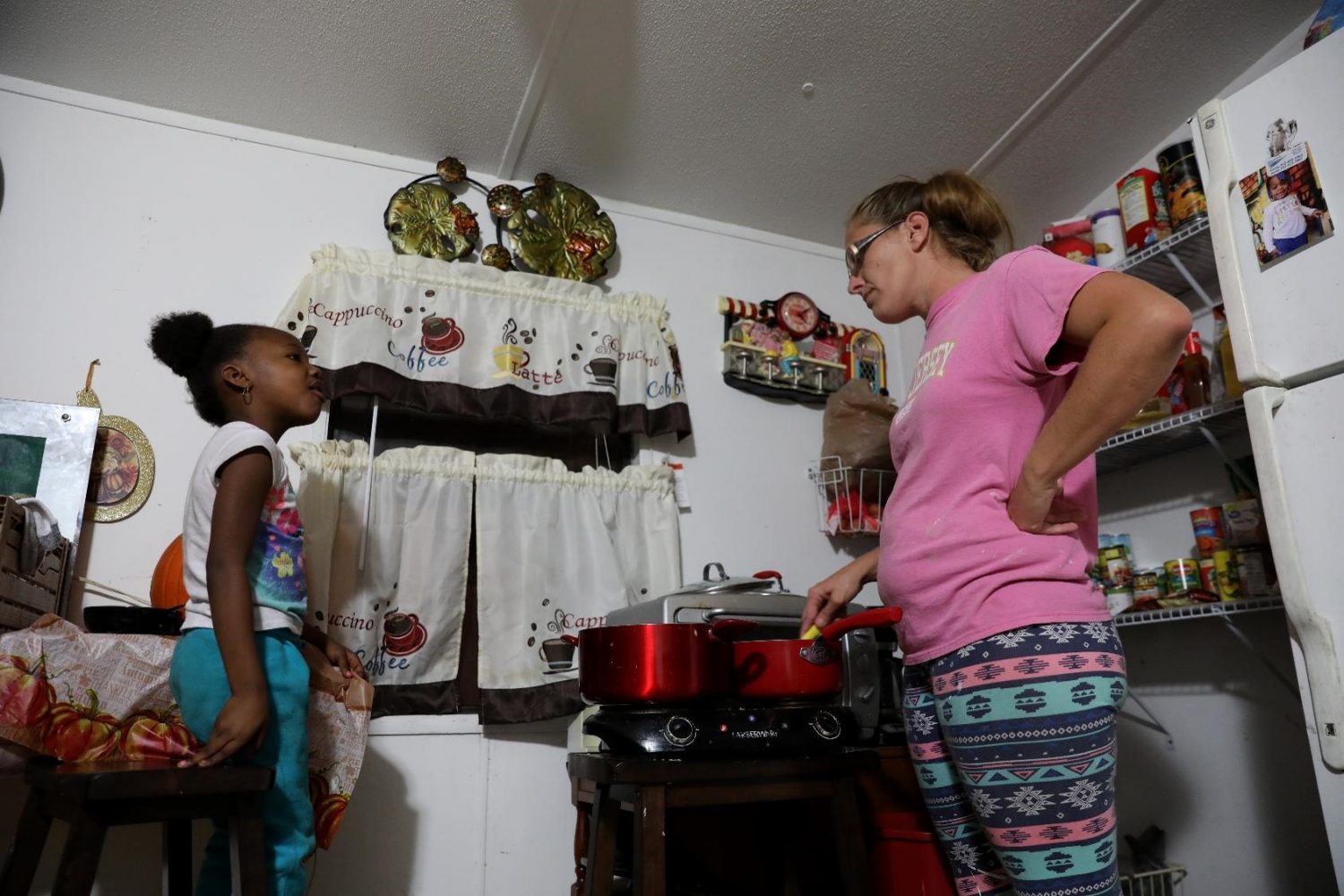A Special Report by WUFT News
By Emily Mavrakis | December 13, 2017
Additional reporting by Danielle Chanzes, Bailey LeFever and Ana-Katarina Stanic
Energy comes at a much greater cost for Gainesville’s poor, from the portion of income spent on utilities to the days without power after Hurricane Irma. A special report on why the poor pay more, and what we can do.
Gainesville’s poorest citizens spend 22 percent of their income on utility bills, a far higher burden than the national average for the poor and more than quadruple what most local families pay as a percentage of income. For some residents, the hardship is severe enough to mean taking on a second job or even losing a home.
While the city’s high energy rates are part of the problem, an analysis of public records and interviews with residents, experts, advocates and others reveal that substandard, inefficient housing is also a factor, particularly in the rental market. Despite more than a decade of community efforts to fix inferior homes, some of Gainesville’s poorest renters still live without basic attic insulation or updated, efficient appliances that keep families comfortable in addition to saving them money and energy.

These are some of the key findings in a three-month investigation into energy and poverty in Gainesville by environmental journalism students in the University of Florida’s College of Journalism and Communications. Their series, Energy Burden, running over five days on WUFT.org, also found:
- Hurricane Irma brought the energy burden faced by low-income residents into sharp – and dark – relief. An analysis of Gainesville Regional Utilities (GRU) power loss data and property-appraiser records shows that, of homes that lost power in the hurricane, the lowest-valued properties stayed dark almost three times longer than the highest-valued. The difference has much to do with the modest homes’ locations in older, flood-prone neighborhoods and unequal infrastructure, such as above-ground vs. buried power lines.
- In some of the poorest Census blocks, residents are actually paying more for utilities per square foot than the average GRU customer. Inefficient homes heighten this disparity, for example, when families without central heat try and keep warm with space heaters or even open ovens.
- The highest number of code violations for poorly maintained rental properties, including gaps and holes that release cool air in the summer and invite it in during winter, are concentrated among the lowest-valued properties.
- After earning a reputation for progressive energy policies such as solar feed-in-tariff earlier in the 2000s, the city has fallen behind other municipalities in new solutions such as incentives for developers to build “tiny houses,” or helping bring more solar power to low-income neighborhoods. City solar-coverage data show that, like the buried power lines, solar has followed the money.
“It brings an awareness of how difficult it is for low-income people to meet their needs,” says analyst Lynn Jarrett of UF’s Program for Resource Efficient Communities, who with colleague Hal S. Knowles III helped students analyze data from GRU records, the U.S. Decennial Census, Alachua County Property Appraiser archives and American Community Survey responses.
On average, Gainesville households spend about 5.5 percent of annual income on utilities. Those in the worst poverty – earning less than $14,369 a year – use the least amount of energy yet spend by far the highest percentage of income on utilities, 22 percent. The next level of low-income residents – those earning between $14,369 and $28,737 – must spend about 11 percent.
The quality of affordable housing available to low-income citizens in Gainesville “is the fundamental challenge,” says Knowles. “If you’re in a substandard housing situation, it’s going to cost you more to reach the same level of service.”
For example, property appraiser data show that more than 8 percent of citizens in some of Gainesville’s poorest Census blocks live without central heat and air, yet these are the same blocks where residents pay the greatest portion of their income for utilities – and may even pay more per square foot. “If I’m making $900 (a month) and spending $150 on electricity, tell me where that leaves me,” says James McCoy, 27, who works full-time at Jason’s Deli and lives in a home without central air and heat.
Along with housing quality, at the heart of the problem are the complex and interdependent challenges of poverty, racial inequality and educational and economic opportunity in concentrated areas of Gainesville. In January, a group called Friendship 7 made up of city and county government, the Gainesville Area Chamber of Commerce, the public schools, Santa Fe College, the University of Florida and UF Health is expected to release a major report on racial inequities to prompt civic discourse – and hopefully long-term solutions.
When it comes to energy disparity, some of the fixes are as straight forward as helping to weatherize homes or ensuring rental properties have at least some basic efficiency. McCoy is not a unique example of residents who cannot get their landlords to fix an appliance required by law – in his case, the nonworking oven.
Earlier this fall, at a summit on poverty organized by the Gainesville Chamber of Commerce, City Commissioner Helen Warren said the community must take a position on low-income housing relationships between tenants and landlords: “The landlord’s profit motive is not connected to community compassion,” she said, “but working on a principle of, ‘the less I put into a house, the more my profit is.’”
Gainesville landlord Jim Konish, an attorney who specializes in utility law, counters that the less a landlord must invest in a rental property, the more affordable it is for the tenants. Blaming landlords for the energy burden on the city’s poor, he says, is a smokescreen to cover up Gainesville’s utility costs, the highest in the state.
“You don’t need efficiency so that you can live in a controlled environment with no windows open, so it’s like the same temperature all the time,” Konish says. “If you have my kinds of houses they’re designed to be comfortable without air conditioning.
“Not everyone is 100 pounds overweight and they need the AC on at 68 degrees to make it through the day,” he adds. “I have numerous tenants who call it artificial air. They don’t even use it.”
GRU’s higher costs
Many residents likewise cite city-owned GRU’s high rates as a key problem. In September 2017, a GRU customer using 1,000 kilowatt hours of power paid more than a resident of Jacksonville, Tallahassee, Orlando or Ocala, or a customer of Florida Power & Light or Tampa Electric Co., according to data from the Florida Municipal Electric Agency.

Atop those costs, during GRU budget hearings in summer 2015, the city commission eliminated a rate structure that benefitted low-usage customers by charging much less for the lowest tier. Before October 2015, GRU had a three-tiered structure that gave a break to those families using the least energy. The utility charged 3.1 cents a kilowatt-hour for customers using up to 250 kilowatt hours a month, 4.2 cents for between 251 and 750; and 8.4 cents for more than 750.
The current two-tiered system charges customers 4.4 cents per kilowatt-hour for up to 850 used, and 6.6 cents per kilowatt-hour for those who use more than that. In other words, families who use the very smallest amounts of electricity saw their bills increase. Residents using more than 850 kilowatt-hours a month saw a decrease. (The average GRU customer uses about 800 kilowatt-hours a month.)
Gainesville Mayor Lauren Poe says the change has created a disincentive for conservation and “essentially gave utility rate cuts to people with large homes and swimming pools and hot tubs that live west of the interstate, and gave hikes to people that live sort of in the core and East.”
Poe says he and Commissioner Adrian Hayes-Santos have both proposed restructuring the tiers over the past two budget cycles, without success. “It just doesn’t have the political support right now,” Poe says.
According to a 2016 report from the American Council for an Energy-Efficient Economy, a Washington, D.C., based nonprofit, the problems of energy inequality are spread across the United States; low-income households pay the greatest percentage of income on utilities nationwide. The most severe burdens are found in the Southeast and Midwest. Energy bills in the Southeast are less expensive than in other regions, but residents tend to have lower incomes, leading to higher burdens. Gainesville is far higher, with the poor paying double-digit percentages of their income for utilities here, compared with a little under 8 percent across the Southeast. Nationwide, those living under the poverty level have an energy burden closer to 7 percent.
The ACEEE report also underscores the local reality that low-income residents often live in inefficient homes, and can end up paying more per square foot in energy costs. Weatherization programs and emergency bill assistance are two traditional solutions. The federal Low-Income Home Energy Assistance Program targets both. In 2016, Alachua County residents received $648,679 in LIHEAP aid, according to the Central Florida Community Action Agency, with about 3,000 homes benefitting from at least one service. That’s about $217 a house. Advocates say local need far outstrips the funding available. GRU’s employees and customers make volunteer contributions to Project SHARE, raising about $65,000 a year in emergency bill help for elderly and disabled customers with financial hardships. But the emergency funds don’t get at the more systematic problems.
Wendell Porter, a UF professor who specializes in sustainable energy, says shoring up homes is crucial not only to lower bills and increase efficiency and comfort, but to reduce the carbon emissions contributing to climate change.
Vanessa Aragon, a residential efficiency program coordinator for GRU, says the utility’s Low-income Energy Efficiency Program Plus works to provide efficiency upgrades and education to help customers save on energy bills. The program has fixed up just over 1,500 homes in the past decade, spending an average $4,200 each on efficient air conditioners, insulation and other needs. But it is available only to HUD low income-qualifying homeowners living in a single-family home built before 1997 or a mobile home.
Renters, who make up 28.8 percent of Alachua’s poor, are not eligible. “It is difficult when you are living there and you can’t move anywhere else and unfortunately your bills are high because nobody will make upgrades,” Aragon acknowledges.
GRU staff have brought several proposals to the city commission or regulatory boards to require basic attic insulation or other efficiency minimums in rental units or at point of sale in the Housing Code. They haven’t gone anywhere.
Community organizations have worked for years to try and fill the gap. The grassroots Community Weatherization Coalition (CWC), launched in 2005 in response to the number of emergency calls to agencies over utility bills, has done 800 home energy surveys since, more than a third of those for rental properties. Volunteers install basic energy and water-saving devices, then partner with other agencies that may be able to help with bigger retrofits. CWC reports it saves households $250 a year on average, or 13 percent of energy and water costs.
Ultimately, advocates for the poor and for energy conservation say, it won’t take one solution, but a broader commitment to make energy in Gainesville more equitable. That includes increasing the number of affordable homes that keep people warm in winter, cool in summer and with more money in their pockets.
What CWC does “works incredibly well,” Poe says. “But there’s only so many houses they can do a year.”
Jarrett says she is hopeful that through community action, energy inequality can be reduced in the city. “You can’t solve the problem if you don’t know the problem,” she says.
“If the community is interested, there are opportunities to improve,” says Jarrett. “And there are definitely people in the community we have seen who are interested and who want to help improve it.”
Up next: The Inequity of a Storm. »
 Special Report from WUFT News
Special Report from WUFT News